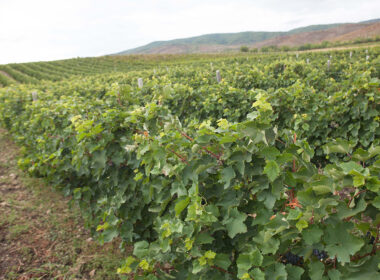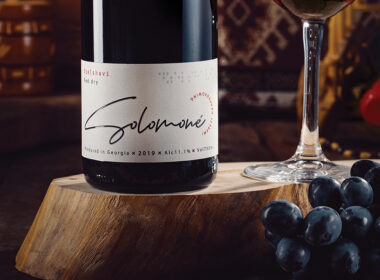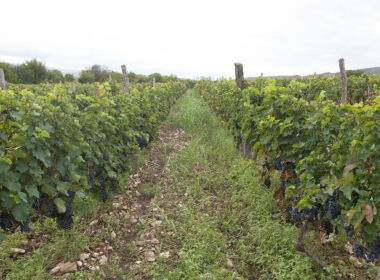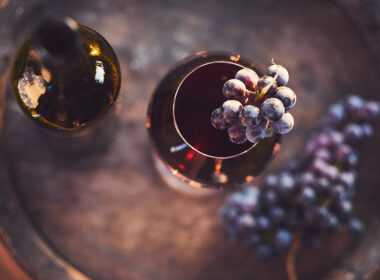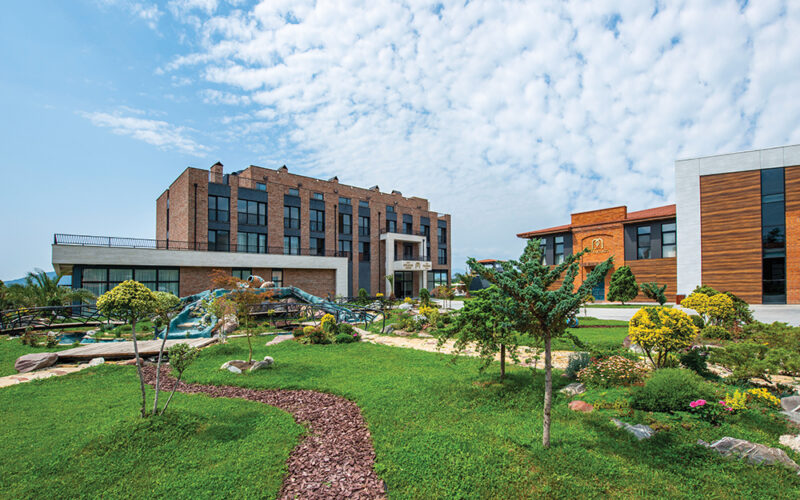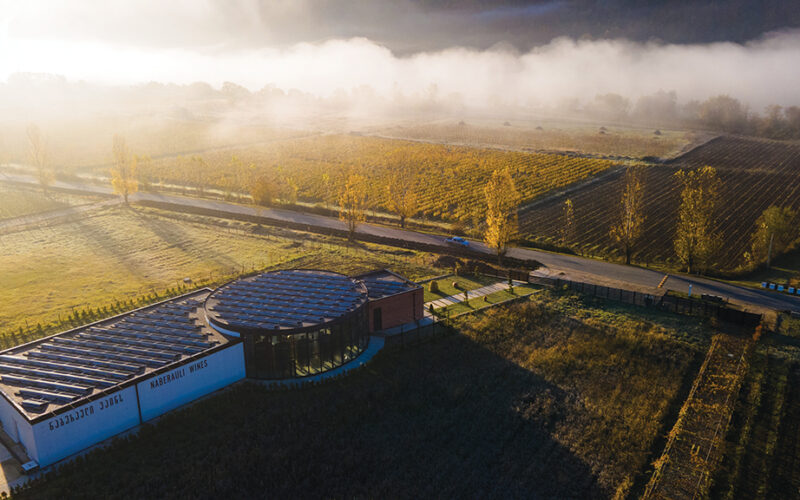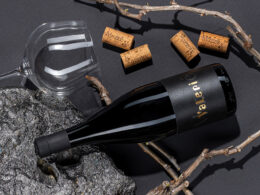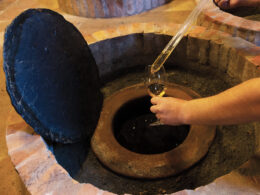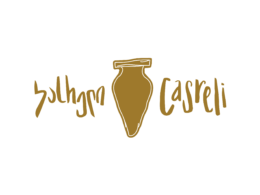| Nana Jojishvili and Katharina Iglesias of WineBank about Gurian wines. |
If I were to pinpoint the colour of childhood, it would be the very colour of Guria. The essence of my youth is still held within the picturesque courtyard of my Gurian grandmother, who had settled in Kartli after her marriage. It’s in the verdant pathways leading to the garden, the sweetness of the white mulberry reaching the balcony of the house, shrivelled dogwood berries on the trees, the Gurian nalia (maize crib) on four legs, and the hefty qvevris nestled next to the wine press.
At the onset of spring, Guria embraces a serene calmness. Before tree buds unfurl and streams start to burble, the marvel of Gurian nature gathers strength. The mist from the Black Sea veils Guria’s mountains, while a light drizzle, akin to maize flour sifting through a sieve, gently falls.
In the summertime, Guria comes alive with joy. People of all ages venture out to pick tea, swiftly gathering the freshly plucked, vibrant green leaves in baskets. As the sun sets, hungry boys and girls, emerging from the river, climb cherry and fig trees with laughter and giggles.
Autumn in Guria mirrors an orange sun descending into the depths of the Black Sea. Not even the fog can veil the gardens adorned with tangerine trees. Scaling all the way up to the treetops, the dewy grapes of the vine ensnare the warmth of the sun, permeating onto the churis (qvevri in western Georgia) planted at its base.
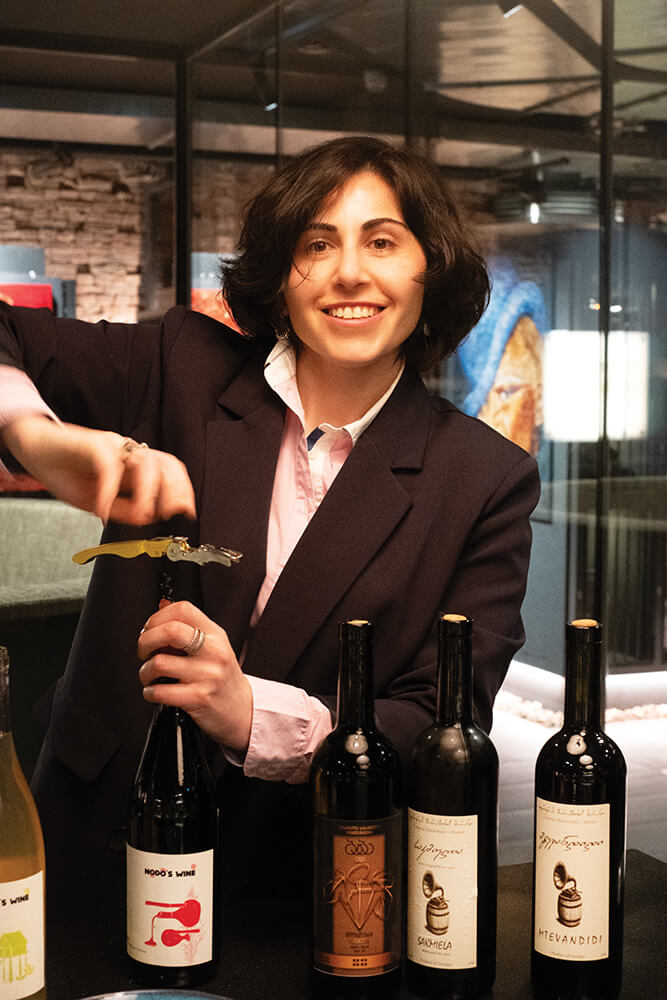
The news that the summer edition of this magazine would focus on this region filled me with joy. I immediately set off from Hamburg to Guria, carrying only a backpack and my childhood memories.
Despite the weather forecast predicting rain in Guria, I was greeted with a sunny spring morning, surprising even the locals. The gentle March breeze, the delicate plum tree blossoms, the crowing of a rooster echoing along the village road, the weathered wooden fences, the fragrance of earth infused with the essence of summer, and the soft sound of vine pruning.
Gurian winemaking is only now beginning to gain momentum. Following the spread of phylloxera, the Soviet Union also inflicted its fair share of damage on it. Initially, tea replaced the unique Gurian vineyards, followed by citrus and finally hazelnut orchards. And now, Gurian winemaking is returning to its historical roots. Winemaking is rapidly developing in the region with many winegrowers expecting their newly planted vineyards to become active, and yield within four years.
The region consists of three municipalities: Chokhatauri, Ozurgeti, and Lanchkhuti. Winemaking is most prevalent in Chokhatauri, followed by Ozurgeti and Lanchkhuti villages.
Currently, Chkhaveri is recognized as the most prevalent red grape variety in Guria. Its historical roots lie in Guria, although it is also widely cultivated in the villages of Ajara and Imereti. Upon reviewing my notes, I realised that my first encounter with Chkhaveri was during a red wine tasting in Imereti. The Chkhaveri I sampled was a notably dark, aged in qvevri, full-bodied wine, representing all of the three wine regions (Guria, Ajara, and Imereti).
For me, Chkhaveri embodies a wild grape variety with an untamable character. Its lighter wines are perfect for spring, transitioning us from the rich, full-bodied reds of winter to the crisp whites and light rosés ideal for hot summer days. Often, you’ll detect subtle hints of smoke in it. This variety is particularly well-suited for rosé wines.
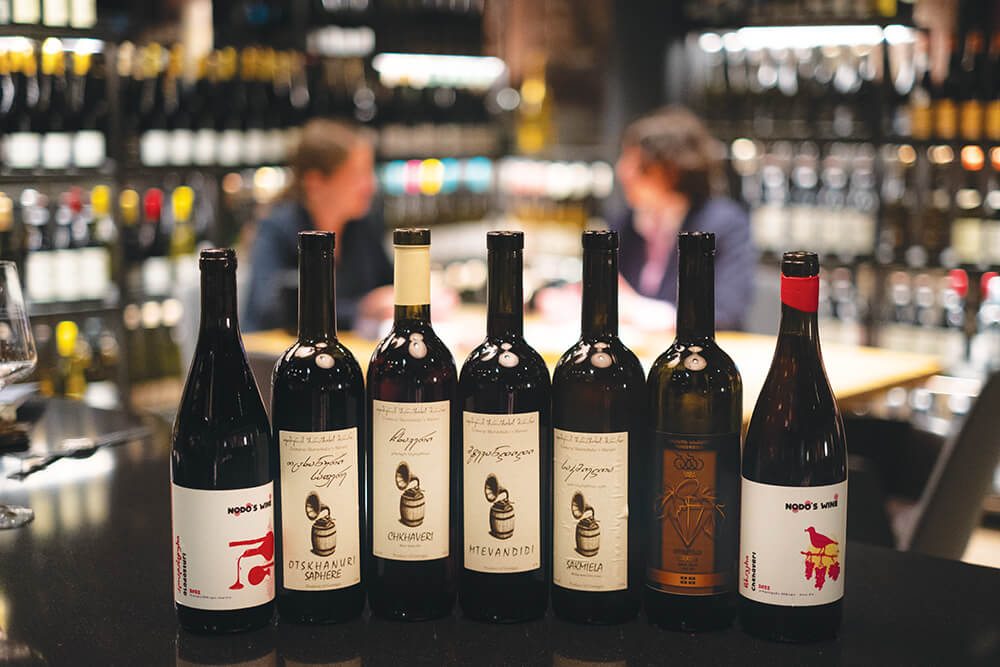
During my time in Guria, I encountered numerous passionate winemakers who had planted new vines in their family’s vineyards just a few years prior. Because of the region’s mountainous terrain, there is limited soil available. For tasting, I chose wines from three small family cellars, each with its own distinct signature:
Nodar Chkhartishvili’s
| Nodo’s Wine |
Tsolikouri, 2022, dry;
Chkhaveri, 2022, dry;
Aladasturi, 2022, dry,
aged in contact with skins for two weeks in qvevri.
Giorgi Tkeshelaidze’s
| Baba’s Cellar|
Tsolikouri, 2022, dry.
Teimuraz Sharashidze’s Marani
Mtevandidi, 2021, dry;
Otskhanuri Sapere, 2021, dry;
Sakmiela, 2021, semi-dry;
Chkhaveri, 2021, semi-dry.
My journey through Guria began in Ozurgeti, home to the small family winery, Nodo’s Wine. Nodar Chkhartishvili, an engineer-constructor by trade, has been involved in the family’s harvests since childhood. In autumn, he fondly recalls harvesting Aladasturi vine bunches from his yard with his grandmother. In 2019, he planted four qvevris in the cellar and began making wine with even greater enthusiasm. From his selection, I chose the 2022 Aladasturi. The wine is brilliant, medium-bodied, with youthful tannins. It is characterised by intense, lively aromas of cherry and currant.
The village of Bukistsikhe, home to Teimuraz Sharashidze’s wine cellar, is situated on the right bank of the Supsa River, at an elevation of 200 metres above sea level. Teimuraz, an experienced winegrower, began cultivating his collection of 35 vine varieties in 1995. These vines are distributed across five different locations within the village of Bukistsikhe. There are four of his wines presented on our tasting table: Sakmiela, Chkhaveri, Otskhanuri Sapere, and Mtevandidi. Personally, I find batoni (Georgian title of respect akin to sir) Teimuraz’s signature wine Mtevandidi to be exceptional. This variety is distinguished by its dark blue to black grapes. Wine crafted from Mtevandidi, with its purple hue, offers a velvety texture, pleasant acidity, and remarkable aromas of ripe red forest fruits.
Baba’s Cellar is situated in the village of Goraberezhouli, on the left bank of the Supsa River. Giorgi Tkeshelaidze, a naturalist winemaker and member of the Natural Wine Association, oversees the vineyard with a commitment to naturalistic principles, which noticeably influences the wine’s quality. His father cultivated the first Tsolikouri vineyard in 1998. I also chose this variety for tasting, as it’s known for its aromas of ripe yellow fruits, sweet flowers, and bananas. The wine has a medium acidity. In Giorgi’s vineyard, alongside Tsolikouri, you’ll find Chkhaveri, Otskhanuri Sapere, Jani, Tsitska, and Skhilatubani planted as well.
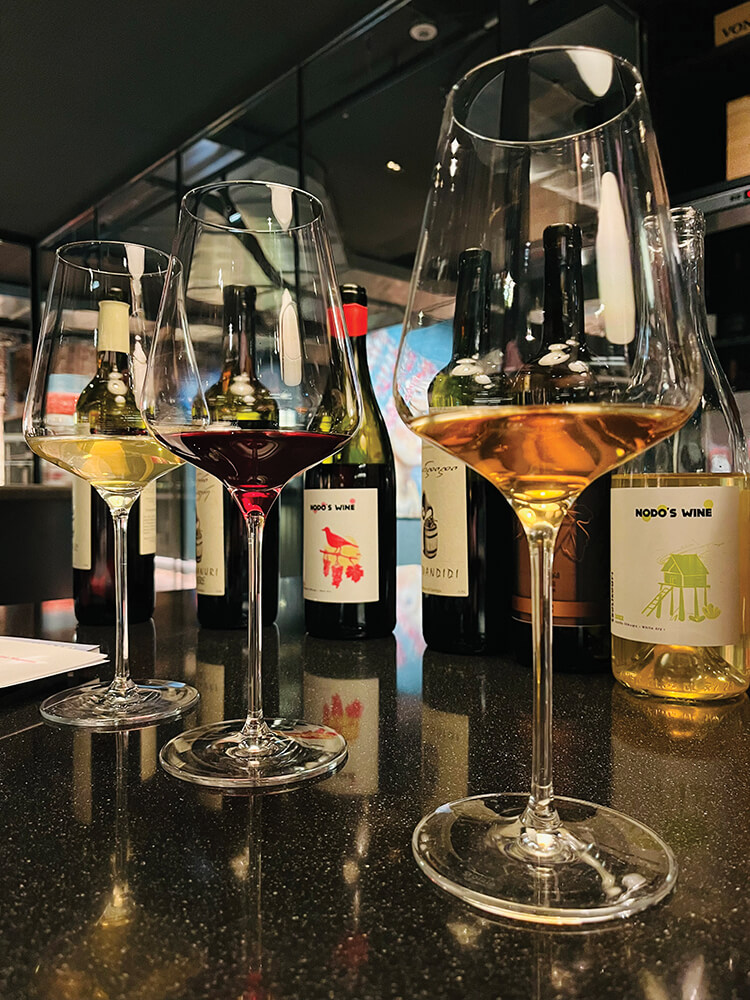
We organised a Gurian wine tasting event at WineBank Hamburg, together with the club’s manager and DWI‘s (Deutsche Weininstitut) 2024 Sommelier Cup winner, Katharina Iglesias.
Founded in 2003 by winemaker Balthasar Ress in Rheingau, WineBank serves as a gathering place for wine enthusiasts and industry professionals alike. With 17 branches worldwide, WineBank extends beyond Germany to multiple countries. The wine list at the Hamburg branch boasts approximately 800 wines from various regions around the globe.

Katharina Iglesias: My relationship with wine began in the German wine region of Pfalz, where Georgian wine remains relatively unknown. It wasn’t until later, during my studies at sommelier school, that I became acquainted with the country of Georgia. It was there that I discovered Georgia’s status as the cradle of wine, boasting an 8000-year-old tradition of winemaking.
Georgian wine is both new and fascinating to me, particularly due to its intriguing grape varieties. However, I find that the names of these varieties and wineries can be somewhat challenging to pronounce. It would be beneficial if wines and wineries had names that were easier to articulate and recall. Struggling to pronounce a wine’s name correctly can feel like a barrier when trying to order it.
Half a year ago, Winebank hosted its first tasting of Georgian wines. The majority of them were qvevri wines, known for their complexity and specificity, not necessarily catering to all consumers. However, today’s tasting presented Georgian winemaking in a new light for me. I discovered that in addition to the traditional method (ageing wine in qvevri for six months in contact with skins and stems), there are stylistically diverse wines from other regions of Georgia which may find it easier to establish themselves in the local market.
If we were to categorise Georgian winemaking into old and new styles, I’d label these wines as representing the new style.
Tannins aren’t prominent in the Gurian wines we tested. Instead, they’re delicate, elegant, and medium-bodied, with a well-balanced acidity and body. They’re quite enjoyable on the palate even without being paired with a dish.
Among the varieties we sampled, Tsolikouri stands out for its intriguing balance of minerality and acidity, along with its aromatic notes of yellow fruits and delicate structure. Chkhaveri, among the reds, particularly captivated me. This wine is very pleasant to drink with its light tannins, gentle acidity, and subtle body, complemented by hints of caramel flavours. I can easily imagine this type of wine being enjoyed here, at WineBank, even without any snacks.
Aladasturi displays aromas of fresh fruits with subtle hints of light spices. Though still young, this wine will further develop with an additional two years of ageing.
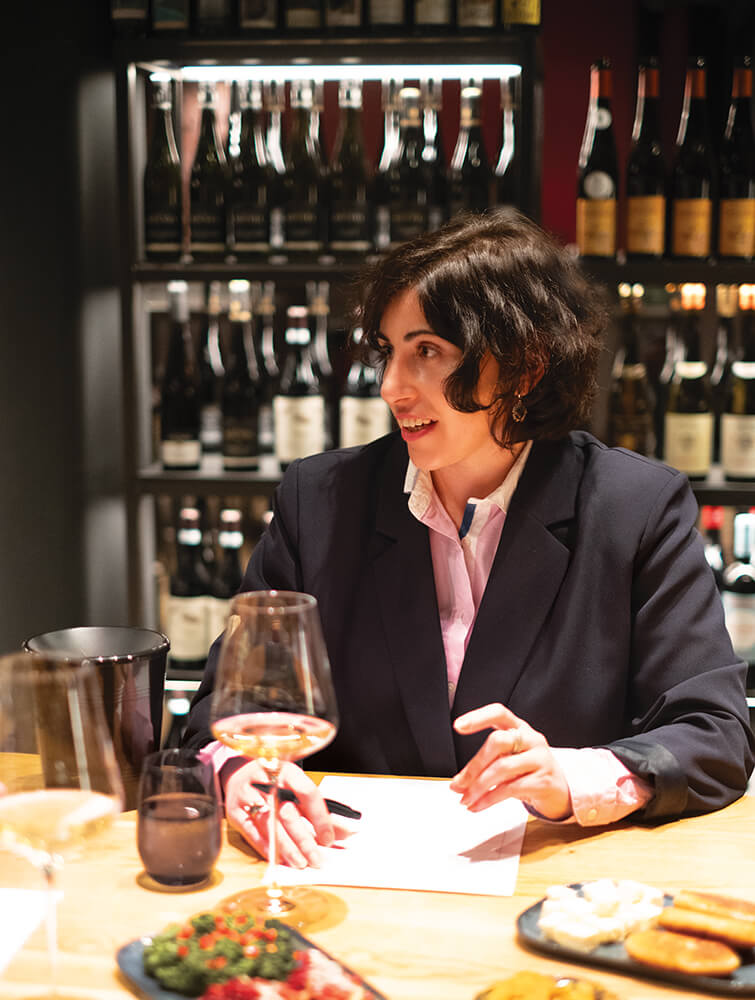
Q: Katharina, how feasible is it to draw parallels between international and Georgian grape varieties?
A: Georgian grape varieties possess unique characteristics, making it challenging to draw direct parallels. However, the Mtevandidi tasted today exhibits a structure and red fruit flavours reminiscent of Pinot Noir. In a blind tasting, I might associate it with Pinot Noir.
There’s a subtle resemblance between Tsolikouri and Riesling, particularly in terms of acidity and minerality, although Riesling typically has higher acidity. Reflecting on Baden-Württemberg, one of Germany’s hotter wine regions, Tsolikouri brings to mind Riesling from a hot vintage in this area. Here, gentle acidity and notes of exotic fruits take precedence over citrus and apple.
As a sommelier, I consider Georgian wine to be in a category that requires some effort to sell. It’s important to explain to guests its origin, unique qualities, and what sets it apart. At Winebank, we often conduct blind tastings, where club members are unaware of what they’re tasting. This offers them an exciting opportunity to explore new and interesting wines. I believe several of the Gurian wines would indeed captivate our club members.
გურული ღვინოების ახალი პერსპექტივები
| ნანა ჯოჯიშვილი და კატერინა იგლესიასი WineBank-იდან გურული ღვინოების შესახებ |
თუკი ბავშვობის ფერი არსებობს ჩემთვის, სწორედ ეს ფერი აქვს გურიას. ბავშვობის ფერი აქვს ქართლში გამოთხოვილ ჩემი გურული ბებიის ლამაზ ეზოსაც, ბაღში მიმავალ მწვანე ბილიკებს, სახლის აივნამდე ამოსული თეთრი თუთის სიტკოს, ხეზე შემჭკნარ შინდის მარცვლებს, ოთხ ფეხზე შემდგარ გურულ ნალიას და საწნახელის გვერდით ჩაყრილ დიდმუცელა ქვევრებს.
გაზაფხულის პირველ თვეში გურია მშვიდია. სანამ კვირტები დაასკდება ხეებს და ნაკადულები აჩუხჩუხდებიან, გურული ბუნების სიმკვირცხლე ძალას იკრებს. შავი ზღვიდან წამოსული ნალექი ნისლებში ხვევს გურიის მთებს. ცრის წვრილად, საცერიდან გამოსული მჭადის ფქვილივით.
ზაფხულის გურია მხიარულია. ჩაის საკრეფადაა გასული დიდი და პატარა. ახლადმოკრეფილ ხასხასა მწვანე ფოთლებს ხელის სწრაფი მოძრაობით კალათში აგროვებენ. საღამოობით, მდინარიდან ამოსული, მოშიებული გოგო-ბიჭები ბლისა და ლეღვის ხეებს კისკისით ესევიან.
გურიაში შემოდგომა შავ ზღვაში ჩამავალ ფორთოხლისფერ მზეს ჰგავს. მანდარინის ხეებით გაფერადებულ ბაღებს ნისლი ვერ ფარავს. ხის კენწერომდე ასულ ვაზის ცვრიან მარცვლებში ახალფეხადგმული სხივის სითბო ვაზის ძირში დარგულ ჭურებამდე აღწევს.
ინფორმაციამ იმის შესახებ, რომ ჟურნალის ზაფხულის ნომერი ამ მხარეს მიეძღვნებოდა, ძალიან გამახარა. ჰამბურგიდან სასწრაფოდ გავეშურე გურიისკენ – ზურგჩანთით და ბავშვობის მოგონებებით.
ამინდის პროგნოზის მიხედვით, გურიაში წვიმა უნდა ყოფილიყო, მაგრამ გაზაფხულის ისეთი მზიანი დილა დამხვდა, გურულები ასეთს თავადაც რომ დიდხანს ელიან ხოლმე. თბილი მარტის სიო, ტყემლის ხეების ყვავილების სინაზე, შარამდე მოსული მამლის ყივილი, ჩაშლილი ხის ღობეები, გამოზაფხულებული მიწის სუნი, ვაზის სხვლის ფრთხილი ხმა.
გურული მეღვინეობა ახლა იწყებს თავიდან ფეხის ადგმას. ფილოქსერას გავრცელების შემდეგ არც საბჭოთა კავშირს დაუკლია მისთვის ავი ხელი. უნიკალური გურული ვაზის ადგილას ჯერ ჩაი გაშენდა, შემდეგ ციტრუსი, ბოლოს თხილის ბაღები. გურული მეღვინეობა ისევ უბრუნდება თავის ისტორიულ საწყისს და სწრაფად ვითარდება. ბევრია ისეთი მევენახეების რიცხვიც, რომელთა ახალადჩაყრილი ვენახები ოთხ წელიწადში აქტიურ მსხმოიარე ფაზაში შევა.
რეგიონი სამი მუნიციპალიტეტისგან შედგება ჩოხატაური, ოზურგეთი და ლანჩხუთი. მეღვინეობა ყველაზე მეტად ჩოხატაურშია გავრცელებული, შემდეგ ოზურგეთსა და ლანჩხუთის სოფლებში.
ამ დროისთვის, გურიაში ყველაზე გავრცელებულ წითელყურძნიან ჯიშად ჩხავერი ითვლება. ისტორიულად, მისი სამშობლო გურიაა, თუმცა ასევე ფართოდაა გავრცელებული აჭარისა და იმერეთის სოფლებში. მოგვიანებით, ჩემს ჩანაწერებში აღმოვაჩინე, რომ პირველად ჩხავერი იმერეთში, წითელი ღვინოების დეგუსტაციისას გავსინჯე. ეს, სამი ღვინის რეგიონის (გურიის, აჭარისა და იმერეთის) ქვევრში დავარგებული, საკმაოდ მუქი შეფერილობის, სხეულიანი ჩხავერი იყო.
ჩხავერი ჩემთვის ცვალებადი ხასიათის, მოუხელთებელი ყურძნის ჯიშია. მისგან დამზადებული მსუბუქი ღვინოები ძალიან უხდება გაზაფხულს, ვიდრე ზამთრის წითელი, სხეულიანი ღვინოებიდან ზაფხულის ცხელი დღეებისთვის შესაფერ თეთრ ღვინოებსა და მსუბუქ როზეზე გადავალთ. მასში ხშირად, კვამლის მსუბუქად გამოკვეთილ არომატებსაც შეხვდებით, რაც გაზაფხულზე, სოფელში დაწყებულ სამიწადმოქმედო პროცესებს მახსენებს. ეს ჯიში ვარდისფერი ღვინოებისთვის შესანიშნავია.
გურიაში უმრავლესობა ენთუზიასტი მეღვინეები დამხვდნენ, რომლებმაც რამდენიმე წლის წინ, მამაპაპისეულ ვენახში ახალი ვაზი გააშენეს. რეგიონი, მთა-გორიანობის გამო, მცირემიწიანია. სადეგუსტაციოდ სამი მცირე საოჯახო მარნის ღვინოები შევარჩიე, რომლებსაც მკვეთრად გამოხატული ხელწერა აქვთ:
ნოდარ ჩხარტიშვილის | Nodo’s Wine |
ცოლიკოური 2022, მშრალი;
ჩხავერი 2022, მშრალი;
ალადასტური 2022, მშრალი,
რომელიც ორი კვირა იყო
ქვევრში დურდოზე.
გიორგი ტყეშელაიძის | ბაბას მარანი |
ცოლიკოური 2022, მშრალი.
თეიმურაზ შარაშიძის მარნის
მტევანდიდი 2021, მშრალი;
ოცხანური საფერე 2021, მშრალი;
საკმიელა 2021, ნახევრად მშრალი;
ჩხავერი 2021, ნახევრად მშრალი.
გურიაში მოგზაურობა ოზურგეთიდან დავიწყე. სწორედ აქ მდებარეობს პატარა საოჯახო მარანი Nodo’s Wine. პროფესიით ინჟინერ-კონსტრუქტორი ნოდარ ჩხარტიშვილი ბავშვობიდან მონაწილეობდა ოჯახის რთველში. იხსენებს, როგორ მარცვლიდა შემოდგომით, ბებიასთან ერთად, ეზოში მდგარ, ახლა უკვე 50 წლის ალადასტურის ვაზის მტევნებს. 2019 წელს, მარანში ოთხი ქვევრი დარგო და ღვინის დაყენებას უფრო დიდი ენთუზიაზმით შეუდგა. მისი ღვინოებიდან 2022 წლის ალადასტური გამოვარჩიე. ღვინო ძოწისფერია, კამკამა, საშუალო სხეულიანი, ახალგაზრდა ტანინებით. ახასიათებს ალუბლისა და მოცხარის ინტენსიური, ცოცხალი არომატები.
სოფელი ბუკისციხე, სადაც თეიმურაზ შარაშიძის მარანი მდებარეობს, მდინარე სუფსის მარჯვენა მხარეს, ზღვის დონიდან 200 მეტრის სიმაღლეზეა. ბატონი თეიმურაზი გამოცდილი მევენახე-მეღვინეა. მის საკოლექციო ნაკვეთში ვაზის 35 ჯიშია წარმოდგენილი, რომელთა გაშენებაც 1995 წლიდან დაიწყო. ვენახები სოფელ ბუკისციხეში 5 სხვადასხვა ადგილზეა განაწილებული.
ჩვენს სადეგუსტაციო მაგიდაზე მისი ოთხი ღვინოა წარმოდგენილი: საკმიელა, ჩხავერი, ოცხანური საფერე და მტევანდიდი. ვფიქრობ, ჩემთვის, ბატონი თეიმურაზის საავტორო ღვინო მტევანდიდია. ამ ჯიშისთვის დამახასიათებელია მუქი ლურჯი, შავ ფერში გარდამავალი ყურძნის მარცვლები. მისგან დამზადებული ღვინო კი იისფერია, ხავერდოვანი გემო, სასიამოვნო მჟავიანობა და ტყის მწიფე წითელი ხილის საოცარი არომატები ახასიათებს.
„ბაბას მარანი“ სოფელ გორაბერეჟოულშია, სუფსის მარცხენა სანაპიროზე. გიორგი ტყეშელაიძე ნატურალისტი მეღვინეა, ის „ბუნებრივი ღვინის ასოციაციის“ წევრია და ვენახსაც ამ მიმართულებით უვლის, რაც ღვინის ხარისხზეც აისახება. პირველი ცოლიკოურის ვენახი 1998 წელს, მისმა მამამ გააშენა. სადეგუსტაციოდაც ეს ჯიში შევარჩიე, რომელსაც ყვითელი მწიფე ხილის, ტკბილი ყვავილებისა და ბანანის არომატები აქვს. ღვინო საშუალომჟავიანია. გიორგის ვენახში, ცოლიკოურის გარდა, ჩხავერი, ოცხანური საფერე, ჯანი, ციცქა და სხილათუბანია გაშენებული.
გურული ღვინოების დეგუსტაცია WineBank Hamburg-ში, ამავე კლუბის მენეჯერთან, DWI (Deutsche Weininstitut) Sommelier-Cup 2024 წლის გამარჯვებულ სომელიე კატერინა იგლესიასთან ერთად გავმართეთ.
WineBank-ი 2003 წელს, რაინგაუში მეღვინეობა Balthasar Ress-ის მიერ დაარსდა და ის ღვინის მოყვარულებსა და პროფესიონალებს აერთიანებს. WineBank-ს 17 ფილიალი აქვს და გერმანიის გარდა, მსოფლიოს არაერთ ქვეყანაშია წარმოდგენილი. ჰამბურგის ფილიალის ღვინის ბარათში კი სხვადასხვა ქვეყნის 800-მდე ღვინოა შესული.
კატერინა იგლესიასი: ჩემი ურთიერთობა ღვინოსთან გერმანიის ღვინის რეგიონ პფალცში დაიწყო. იქ ქართულ ღვინოს ნაკლებად იცნობენ. თქვენი ქვეყნის შესახებ მოგვიანებით, სომელიეს სკოლაში სწავლისას შევიტყვე, სადაც გავიგე, რომ საქართველო ღვინის სამშობლოა და მას ღვინის წარმოების 8000-წლიანი ტრადიცია აქვს.
ქართული ღვინო და ყურძნის ჯიშები ჩემთვის ახალი და საინტერესოა. თუმცა სახელწოდებების გამოთქმა ცოტა რთულია. სასურველია, ღვინოს და მეღვინეობებს ისეთი სახელები ერთქვათ, რომლებიც ადვილად წარმოსათქმელი და დასამახსოვრებელი იქნება. ერთგვარი ბარიერია, როცა ისეთ ღვინოს უკვეთავ, რომლის სწორად წარმოთქმა გიჭირს.
პირველად, ვაინბანკში, ქართული ღვინოების დეგუსტაცია ნახევარი წლის წინ გაიმართა. მათი უმეტესობა ქვევრის საკმაოდ კომპლექსური ღვინოები იყო. დღევანდელი დეგუსტაციიდან კი ქართული მეღვინეობა სულ სხვა თვალით დავინახე. აღმოვაჩინე, რომ ტრადიციული მეღვინეობის გარდა, რაც ქვევრში 6 თვე ღვინის ჭაჭა-კლერტზე დაყენებას გულისხმობს, საქართველოში სხვა რეგიონის განსხვავებული სტილისტიკის ღვინოებიც არის, რომლებიც აქაურ ბაზარზე თავის დამკვიდრებას მარტივად შეძლებენ.
თუკი შეიძლება, საქართველოს მეღვინეობა ძველ და ახალ მეღვინეობად დავყოთ, ამ ტიპის ღვინოებს ახალი სტილისტიკის ღვინოებს ვუწოდებდი.
გასინჯულ გურულ ღვინოებში ტანინი დომიმანტი არ არის. პირიქით, ღვინოები ნაზი, ელეგანტური და საშუალო სხეულიანია. მჟავიანობა და სხეული კარგად არის დაბალანსენული. მათი მირთმევა კერძის გარეშეც ძალიან სასიამოვნოა.
გასინჯული ჯიშებიდან გამოვარჩევ ცოლიკოურს, რომელსაც აქვს მინერალურობის და მჟავიანობის სასიამოვნო ბალანსი, ყვითელი ხილის არომატები, ნაზი სტრუქტურა.
წითლებიდან ყველაზე მეტად ჩხავერი მომეწონა. ღვინო ძალიან სასიამოვნო დასალევია, მსუბუქი ტანინები, სხეული და ნაზი მჟავიანობა აქვს. გვხვდება კარამელის სასიამოვნო არომატებიც. ასეთი ტიპის ღვინო, ჩვენთან, WineBank-ში მისაყოლებელის გარეშეც წარმომიდგენია.
ალადასტურს კი ცოცხალი ხილისა და მსუბუქი სანელებლების არომატები აქვს. ის ჯერ ახალგაზრდაა, ამ ღვინოს ორწლიანი დავარგება ძალიან მოუხდება.
Q: კატერინა, რამდენად შესაძლებელია საერთაშორისო და ქართულ ყურძნის ჯიშებს შორის პარალელების გავლება?
A: ქართულ ყურძნის ჯიშებს გამოკვეთილი ხასიათი აქვს. პარალელების გავლება რთულია, თუმცა დღეს გასინჯული მტევანდიდი თავისი სტრუქტურითა და წითელი ხილის არომატებით პინო ნუარს ჰგავს. ბრმა დეგუსტაციაზე ასოციაცია ალბათ სწორედ პინო ნუართან მექნებოდა.
ცოლიკოურსა და რისლინგს შორის მსუბუქი პარალელის გავლება მჟავიანობით და მინერალურობით შეიძლება. რისლინგის მჟავიანობა რასაკვირველია, უფრო მაღალია. ბადენ-ვურტემბერგი ერთ-ერთი ცხელი ღვინის რეგიონია გერმანიაში – ცოლიკოური სწორედ ამ რეგიონის ცხელი წელიწადის მოსავლის რისლინგს მაგონებს, სადაც ნაზი მჟავიანობა და ეგზოტიკური ხილის არომატები უფრო ჭარბობს, ვიდრე ციტრუსისა და ვაშლის.
ჩემთვის, როგორც სომელიესთვის, ქართული ღვინო იმ კატეგორიაშია, რომლის გაყიდვაზეც უნდა იმუშაო, სტუმარს უნდა აუხსნა რა ჯიშია, საიდანაა, რაშია მისი განსაკუთრებულობა. ჩვენთან, ვაინბანკში, ყველაზე საინტერესო ის არის, რომ ტარდება ფარული დეგუსტაციები და კლუბის წევრებმა ხშირად არ იციან, რას სინჯავენ. ეს კი კარგი საშუალებაა, ყოველთვის ახალი, საინტერესო ღვინოები გავასინჯო მათ. გურული ღვინოებიდან რამოდენიმე, ვფიქრობ, ნამდვილად იქნება საინტერესო ჩვენი კლუბის წევრებისთვის.

